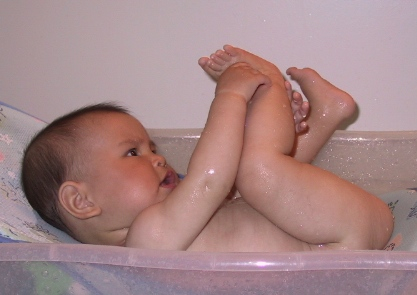The first time a child discovers their feet is a profound experience!
How can ‘Movement with Attention’ support you to support your child’s progress?
We move throughout the day, whether we’re accomplishing tasks or going from one place to the next. When was the last time you paid attention, and were really attentive to what you were doing? A few quick examples for you which I know are often outside of my own awareness:
- Do you know how many steps there are in the flight of stairs within your home or apartment building?
- Which arm did you first use to put on your jacket this morning?
- Which foot did you put your shoe on first?
- Which side of your mouth do you prefer to chew your food with?
- When was the last time you paid attention to what you were doing, really aware of how you were feeling?
Like me, do you sometimes find yourself rushing through tasks, especially if they are unpleasant. It would seem as if we want to escape from or disassociate ourselves from these kinds of experiences. While we’re learning something new we know we need to pay attention to the details so that we’ll be able to recall it later with greater accuracy. Being present to what we’re doing allows us greater clarity in how we feel about what we’re doing. The same applies for your child when they are learning new ways to move.
Movement with Attention is crucial for your child’s success.
- It keeps your child interested and attentive to their novel feeling of pleasure as a result of the new movement.
- It greatly enhances the likelihood that your child will be able to remember, repeat and thus retain their learning.
- This applies to learning movements as well as cognitive development and gaining an understanding of relationships, both to themselves and to the world around them.
Alternatively, when your child is disinterested, they are more likely to dissociate themselves from their experiences. In other words, your child could be ‘actively’ blocking the information that is coming in. Flexible goals (which I wrote about in my previous issue) allow us to be more relaxed and better able to immerse ourselves in the experience of moving with attentiveness, rather than striving for specific outcomes. It provides the much needed space and time for you to support your child to learn and to move with attentiveness.
An actively learning child is a happy child! Movement with attention supports you to be more sensitive to your child’s feelings, which in turn supports them to learn at an elevated rate and to enjoy the process at the same time.
Practical Tools for you to try
Depending on the challenges your child is facing, they rely on your support in varying degrees. Your added support will help your child feel movement in ways they are not able to achieve on their own. Your child’s attentiveness to these movements enables them to connect with their own internal experience and support them to learn to move in a purposeful way.
So here are a few ideas for you…
Every now and them, slow down your daily routine with your child.
Brush your child’s teeth slowly, talk to your child and tell them stories about how the ‘tooth brush fairy’ greets the teeth when traveling in their ‘Mouth Kingdom’. Challenge your own creativity to see how much you can engage your child’s attention. Put your child’s clothes on slowly. Support your child to feel ‘reaching forward’ with one hand and then the other. Help you child put their socks and shoes on slowly, allowing the space for your child to anticipate the next action and participate in it.
Take a long bath with your child or luxuriate in washing them.
Use soap (shaped like animals, if you can find them, to increase the fun factor) to slowly take your child on a journey of exploration to the different parts of their body. Show them how the ‘soap animals’ takes a journey (shortest or squiggly path) to travel from one hand to the other, from the right hand to the left foot or simply ‘skating’ on the tummy. Let your imagination run wild. Give your child your time and attention, and watch the rewards it will give you both.
From time to time, pause or slow down whatever you’re doing with your child.
When feeding your child, slowly put the spoon into their mouth. Pause for a moment. Wait to see what your child will or will not do, before taking the spoon out slowly. Extend this degree of attentiveness to your daily interaction with your child, your child’s play activities and their home therapy program.
When you get your child’s attention by deliberately changing the rhythm of what you do, you are helping your child pay greater attention to what they’re doing. You will become more attentive yourself, and both you and your child will receive greater enjoyment from the task at hand.
QUESTIONS FOR YOU TO PONDER:
- When was the last time I paused to check in with how I feel or felt?
- Which areas of my life would I like to pay more attention to?
- How could I be more attentive to myself? My child?
- What would change as a result?
Now it’s up to you to engage yourself in this process.

